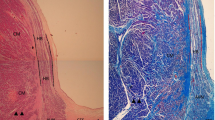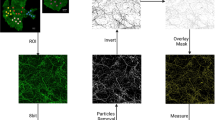Abstract
To confirm the role of HNK-1 in conduction tissue, the ultrastructural localization of monoclonal antibody HNK-1 was analyzed in developing rat hearts at embryonal day 14.5 by immunoelectron microscopic labeling procedures with post-embedding immunogold staining. Tissue sections in different planes containing the sino-atrial (SA) node, atrio-ventricular (AV) node and His bundle were used to demonstrate HNK-1. Immunogold labeling was detected on the cell surfaces and in the extracellular matrices of cells that had features common to conduction tissue cells. Non-specialized contractile myocytes were not labeled by this antibody. Furthermore, immunogold labeling was more prominent in wide intercellular spaces than in narrow intercellular spaces, and rarely observed in cell-cell contact regions. The cell surfaces and extracellular matrices of mesenchymal cells in the endocardial cushion, which contacts the His bundle, were also positive, suggesting the involvement of tract formation to the AV node. These findings may indicate that HNK-1 plays an important role in cell-cell adhesion processes both temporally and spatially in the developing conduction tissue. It was concluded, therefore, that HNK-1 is a suitable marker of the embryonic heart conduction system and might be useful in analyzing anomalous conduction systems, as in congenital heart disease.
Similar content being viewed by others
References
Abo T, Balch CM (1981) A differentiation antigen of human NK and K cells identified by a monoclonal antibody (HNK-1). J Immunol 127:1024–1029
Benninghof A (1923) Über die Beziehungen des Reizleitungssystems und der Papillarmuskeln zu den Konturfasern des Herzschlauches. Anat Anz 57:185. Cited in: Wellens HJJ, Lie KI, Janse MJ (eds) (1976) The conduction system of the heart. Nijhoff, Hague
Bollensen E, Schachner M (1987) The peripheral myelin glycoprotein P0 expresses the L2/HNK-1 and L3 carbohydrate structures shared by neural adhesion molecules. Neurosci Lett 82:77–82
Chou DK, Ilyas AA, Evans JE, Costello C, Quarles RH, Jungalwara FB (1986) Structure of sulfated glucuronyl glycolipids in the nervous system reacting with HNK-1 antibody and some IgM paraproteins in neuropathy. J Biol Chem 261:11717–11725
Dodd J, Morton SB, Karagogeous D, Yamamoto M, Jessel TM (1988) Spatial regulation of axonal glycoprotein expression on subsets of embryonic spinal neurons. Neuron 1:105–116
Finlay M, Anderson RH (1974) The development of cholinesterase activity in the rat heart. J Anat 117:239–248
Fushiki S, Schachner M (1986) Immunocytological localization of cell adhesion molecules L1 and N-CAM and the shared carbohydrate epitope L2 during development of the mouse neocortex. Dev Brain Res 24:153–167
Gorza L, Vitadello M (1989) Distribution of conduction system fibers in the developing and adult rabbit heart revealed by an antineurofilament antibody. Circ Res 65:360–369
Gorza L, Saggin L, Sartore S, Ausoni S (1988) An embryonic-like myosin heavy chain is transiently expressed in nodal conduction tissue of the rat heart. Mol Cell Cardiol 20:931–941
Gowda DC, Margolis RU, Margolis RK (1989) Presence of the HNK-1 epitope on poly(N-acetyl lactosaminyl) oligosaccharides and identification of multiple core proteins in the chondroitin sulfate proteoglycans of brain. Biochemistry 28:4468–4474
Hynes MA, Dodd J, Jessel TM (1989) Carbohydrate recognition, cell interactions, and vertebrate neural development. In: Margolis RU, Margolis RK (eds) Neurobiology of glycoconjugates. Plenum Press, New York, pp 337–365
Ikeda T, Iwasaki K, Shimokawa I, Sakai H, Ito H, Matsuo T (1990) Leu-7 immunoreactivity in human and rat embryonic hearts, with special reference to the development of the conduction tissue. Anat Embryol 182:553–562
Ito H, Iwasaki K, Ikeda T, Sakai H, Shimokawa I, Matsuo T (1992) HNK-1 expression pattern in normal and bis-diamine-induced malformed developing rat heart: three-dimensional reconstruction analysis using computer graphics. Anat Embryol 186:327–334
Keilhauer G, Faissner A, Schachner M (1985) Differential inhibition of neurone-neurone, neurone-astrocyte and astrocyte-astrocyte adhesion by L1, L2 and N-CAM antibodies. Nature 316:728–730
Kruse J, Mailhammer R, Wernecke H, Faissner A, Sommer I, Goridis C, Schacher M (1984) Neural cell adhesion molecules and myelin-associated glycoprotein share a common carbohydrate moiety recognized by monoclonal antibodies L2 and HNK-1. Nature 331:153–155
Kruse J, Keilhauer G, Faissner A, Timpl R, Schachner M (1985) The J1 glycoprotein: a novel nervous system cell adhesion molecule of the L2/HNK-1 family. Nature 316:146–148
Künemund V, Jungalwala FB, Fischer G, Chou DKH, Keilhauer G, Schachner M (1988) The L2/HNK-1 carbohydrate of neural cell adhesion molecules is involved in cell interactions. J Cell Biol 106:213–223
Lamers WH, Kortschot A, Los JA, Moorman AFM (1987) Acetylcholinesterase in prenatal rat heart: a marker for the early development of the cardiac conductive tissue? Anat Rec 217:361–370
Lamers WH, Geerts WJC, Moorman AFM, Dottin RP (1989) Creatinine kinase isozyme expression in embryonic chicken heart. Anat Embryol 179:387–393
Login GR, Galli SJ, Morgan E, Arizono N, Schwartz LB, Dvorak AM (1987) Rapid microwave fixation of rat mast cells. Lab Invest 57:592–599
McGarry RC, Helfand SL, Quarles RH, Roder JC (1983) Recognition of myelin-associated glycoprotein by the monoclonal antibody HNK-1. Nature 306:376–378
Mochet M, Moravec J, Guillemot H, Hatt PY (1975) The ultrastructure of rat conductive tissues; an electron microscopic study of the atrioventricular node and the bundle of His. J Mol Cell Cardiol 7:879–889
Nakagawa M, Thompson RP, Terracio L, Borg TK (1993) Developmental anatomy of HNK-1 immunoreactivity in the embryonic rat heart: co-distribution with early conduction tissue. Anat Embryol 187:445–460
Pesheva P, Horwitz AF, Schachner M (1987) Integrin, the cell surface receptor for fibronectin and laminin, expresses the L2/HNK-1 and L3 carbohydrate structures shared by adhesion molecules. Neurosci Lett 83:303–306
Riopelle RJ, McGarry RC, Roder JC (1986) Adhesion properties of a neuronal epitope recognized by the monoclonal antibody HNK-1. Brain Res 367:20–25
Sanders E, De Groot IJM, Geerts WJC, De Jong F, Horssen AA van, Los JA, Moorman AFM (1986) The local expression of adult chicken heart myosins during development. 2. Ventricular conduction tissue. Enat Embryol 174:187–193
Viragh S, Challice CE (1977a) The development of the conduction system in the mouse embryo heart. 1. The first embryonic A-V conduction pathway. Dev Biol 56:382–396
Viragh S, Challice CE (1977b) The development of the conduction system in the mouse embryo heart. 2. Histogenesis of the atrioventricular node and bundle. Dev Biol 56:397–411
Viragh S, Challice CE (1980) The development of the conduction system in the mouse embryo heart. 3. The development of sinus muscle and sinoatrial node. Dev Biol 80:28–45
Viragh S, Challice CE (1982) The development of the conduction system in the mouse embryo heart. 4. Differentiation of the atrioventricular conduction system. Dev Biol 89:25–40
Wenink ACG (1976) Development of the human cardiac conducting system. J Anat 121:617–631
Author information
Authors and Affiliations
Rights and permissions
About this article
Cite this article
Sakai, H., Ikeda, T., Ito, H. et al. Immunoelectron microscopic localization of HNK-1 in the embryonic rat heart. Anat Embryol 190, 13–20 (1994). https://doi.org/10.1007/BF00185842
Accepted:
Issue Date:
DOI: https://doi.org/10.1007/BF00185842




